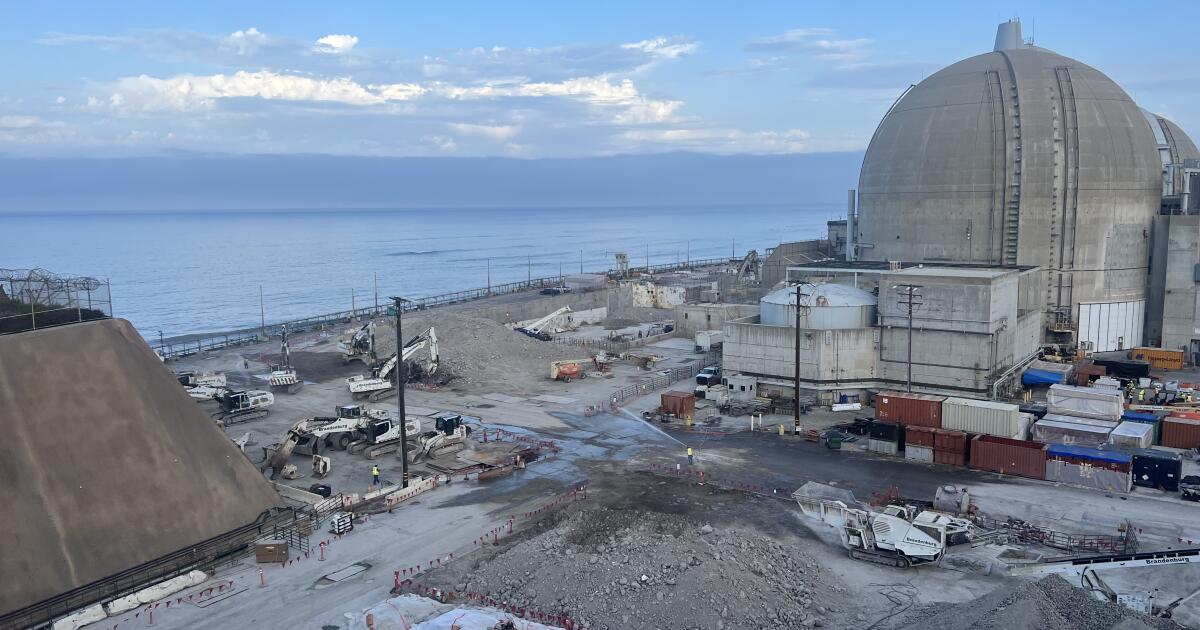
While it may be difficult to see as drivers zoom past the two distinctive domes on the west side of Interstate 5, the dismantlement of the San Onofre nuclear power plant is more than 60 percent complete.
“We’re just under two-thirds of the way through,” said Vince Bilovsky, director of the decommissioning project at the San Onofre Nuclear Generating Station, known as SONGS for short. “We’re where we need to be.”
Demolition work on the eight-year, $4.7 billion project started in October 2020 and is scheduled to finish by the end of 2028.
The scope of the job is massive. About 1.1 billion pounds of equipment, components, rebar, concrete, steel and titanium will be removed. About 80 percent of the material is presumed to be radioactive.
“My wife always asks me, ‘What do you do for a living?’ and I always say, ‘I get paid to worry,’” Rich Kalman, executive sponsor at SONGS Decommissioning Solutions, said during a virtual meeting last month that reviewed the progress of the dismantlement. “Make sure we do it safely, and keep everyone out of harm’s way. That’s my major job at SONGS.”
The vast majority of the plant’s material is labeled Class A waste, the lowest level of radioactive material. Most of the rubble goes by rail to a disposal facility in Clive, Utah.
Class B and C low-level waste get sent to a site near the town of Andrews in West Texas. Non-radioactive material goes to Las Vegas for recycling or a landfill facility in Arizona.
About 900 rail-car shipments have sent more than 300 million pounds out of the 84-acre facility and by the time the dismantlement wraps up, some 5,500 will be completed.

A rail car pulls into the San Onofre Nuclear Generating Station. Debris from the plant is loaded onto the cars as part of a $4.5 billion dismantlement project.
(Nelvin C. Cepeda/The San Diego Union-Tribune)
Rail shipments are monitored by the U.S. Nuclear Regulatory Commission and the Department of Transportation. A host of local, state and federal agencies that include the San Diego Regional Water Quality Control Board, the state’s Department of Toxic Substances Control and the U.S. Environmental Protection Administration also conduct environmental and building inspections.
One of the most complex parts of the dismantlement deals with literally cutting out the internal components from two reactor vessels — one in the Unit 2 containment dome and the other in Unit 3.
Since the internal parts were close to nuclear fuel, the components are radioactive. That means the process of cutting and retrieving the pieces is done underwater, making the job slow and painstaking.
“Because it’s radioactive, you need to shield yourself from it, and water is an excellent shield for radioactivity,” Bilovsky said. “It’s tough to get machinery to be reliable underwater. It’s a complicated design and it’s a lot harder to operate … You’re using remote operations, underwater cameras, manipulators and things like that.”
Work in the reactor cavities is about 96 percent done, Bilovsky said. When finished, the hundreds of thousands of gallons of water will be purified to the level of acceptable drinking water so they can safely be discharged into the ocean.
Once the reactor vessels are segmented and large components removed, workers will then focus on the most visible part of the dismantlement — taking down the two iconic containment domes, each 190 feet high, that drivers on I-5 know all too well.
But they won’t come down in one fell swoop. Instead, the domes will come down gradually, from the bottom up.

Workers using hydraulic hammers will chip away at the 160-foot wide circumference and, in stages, each dome will eventually fall and collapse onto itself, 8 feet at a time.
Bilovsky said one dome will come down first, followed by the other — although it’s not yet finalized whether Unit 2 will go first or Unit 3 will get the nod. The chipping is scheduled to begin in the first quarter of 2026. It will take about eight to nine months to reduce each dome to rubble.
“When those buildings come down, we’re getting really close to the end of the demolition,” Bilovsky said.
Once the dismantlement is complete, all that is expected to remain at SONGS will be two dry storage facilities; a security building with personnel to look over the waste; a seawall 28 feet high, as measured at average low tide at San Onofre Beach; a walkway connecting two beaches north and south of the plant, and a switchyard with power lines.
The switchyard’s substation without transformers stays put because it houses electricity infrastructure that provides a key interconnection for the power grid in the region.
The dry storage facilities on the north end of the plant house canisters filled with 3.55 million pounds of spent nuclear assemblies, dating back to the time when SONGS generated electricity. One storage facility contains 73 stainless steel canisters that have been lowered into vertical cavities. The other holds 50 canisters that are stacked horizontally.
Another 13 canisters of material from the dismantlement that are classified as greater than Class C waste will go into the horizontal storage facility. Eleven of those canisters are already there and two more are expected to be placed in the first quarter of next year.
Until there’s a place to send all the canisters from the two storage facilities, SONGS will not be considered fully decommissioned.
That’s because, as is the case at nuclear plants across the country, the federal government has not found a permanent repository to store the roughly 89,000 metric tons of waste that has built up over the decades at commercial nuclear power plants in 35 states.
Yucca Mountain in Nevada had been slated to take the waste but the Obama administration cut off funding for the site in 2010, following years of protests from lawmakers in the Silver State who had long opposed the project.
The Biden administration, through the U.S. Department of Energy, has kicked off efforts to find communities in the U.S. that would consider taking at least some of the waste on an interim basis.
The $4.7 billion dismantlement project at SONGS will be paid from a decommissioning fund collected through rates paid by Southern California Edison and San Diego Gas & Electric customers when SONGS produced electricity.
A leak in a steam generator tube in 2012 led to the closing of the plant.






